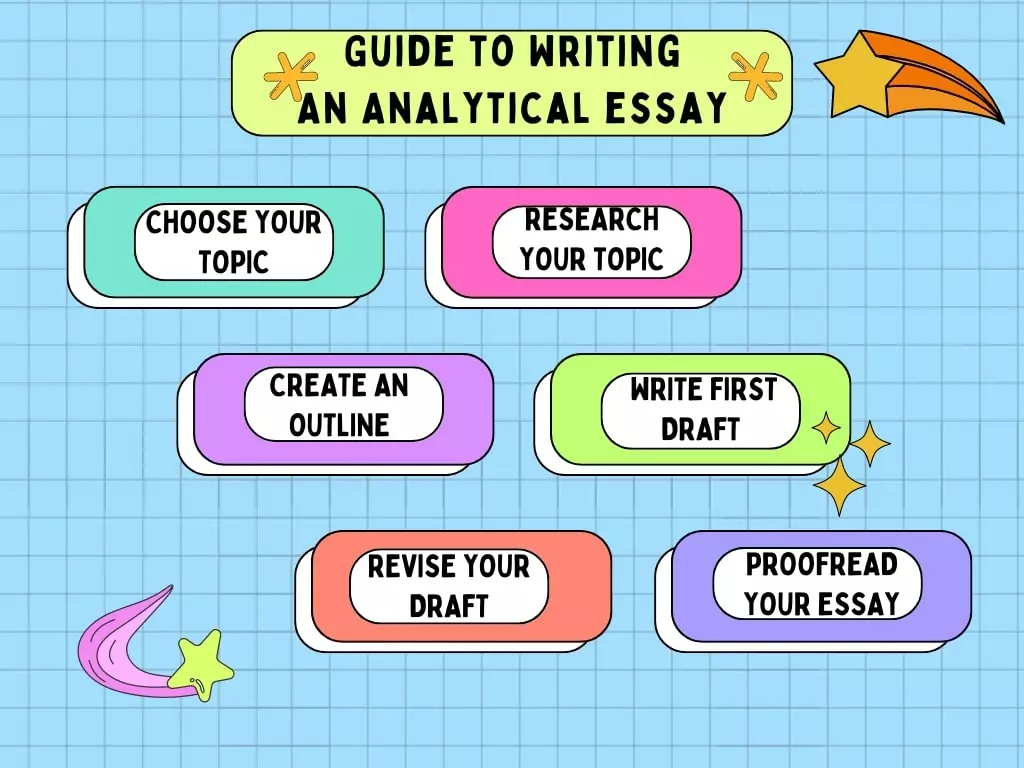How to Write an Analytical Essay

If you are a high school or university student, you most likely have already been asked to write at least one paper in the analytical essay format (though it was also probably more than just one essay too). Have you nailed it down right from the start though? Did you include all the necessary components such as a thesis statement and evidence to support the analysis points you made? If you have skipped at least something of these, then you can win a lot from reading this article. The guide below will show you all the necessary steps you need to take to write a quality analytical essay as well as give you a clear understanding of all the components you need to include to reach the highest grade.
What is an Analytical Essay
An analytical essay is a type of writing that digs deep into a specific topic to break it down and offer a detailed examination. This type of essay goes beyond just describing something—it explores the how and why behind a subject. Analytical essays are commonly assigned in academic settings because they challenge you to think critically about literature, film, politics, science, and current events. They’re beneficial for exploring creative works, like novels or movies, because they help find underlying themes and hidden meanings of the texts.
One of the key features of an analytical essay is its focus on facts and logic. The goal isn’t to give personal opinions or feelings, but rather to analyze a subject based on solid evidence. That’s why in this type of writing you need to use a clear and structured approach to present arguments, with each point backed up by facts or examples. Analytical essays are often found in magazines and academic journals as well, offering readers a deeper understanding of topics they may not be familiar with. Practice in this style of writing helps build strong analytical skills and trains you to think more logically and present your ideas in a well-organized way.

First Step: Creating an Analytical Essay Outline
The first thing you need to do even before starting writing is create an outline. A well-organized essay typically includes three main sections: an introduction, body paragraphs, and a conclusion. Each of these parts serves a specific purpose and needs to be structured carefully so that you can present a coherent analysis (you can use our Essay Maker for a first draft). Let’s break down each section.
- Introduction
The introduction is your chance to set the stage for your analysis. Start with a strong hook to grab the reader’s attention—this could be a rhetorical question, an intriguing fact, or a bold statement that relates to your topic. Avoid starting with something too generic, like “This essay is about…” Instead, go for something that ignites curiosity. After the hook, provide some background information that gives context to your analysis. This could be a brief overview of the topic or an explanation of why it’s important. End the introduction with a clear and specific thesis statement. This thesis should outline the main argument or point of analysis in your essay. For example, if you’re writing about a novel, your thesis might explore how the main character evolves throughout the story.
- Body Paragraphs
The body of the essay is where the real analysis happens. Typically, you’ll have several body paragraphs, each focused on a specific point that supports your thesis. Here are some tips to organize them better:
- Begin each paragraph with a topic sentence that introduces the main idea of the paragraph.
- From there, present evidence—such as quotes, examples, or data—that supports your point.
- The key here is to provide a detailed analysis after the evidence, explaining how it backs up your thesis. For instance, if you’re analyzing a film, one paragraph might focus on how lighting affects the mood, while another could explore how character dialogue shapes the narrative.
Make sure that each paragraph stays focused and directly connects back to your thesis, so your argument remains clear and organized.
- Conclusion
The conclusion brings everything together, summarizing the main points and restating the thesis in light of the evidence you’ve provided. This is not the place to introduce new information, but rather to reinforce the analysis you’ve already made. A strong conclusion gives the reader a sense of closure and finality, helping them see the bigger picture. You might also draw connections between your analysis and broader societal or historical issues, giving your essay an additional layer of depth.
By structuring your analytical essay in this way, you set yourself up for well-organized and persuasive writing. The outline keeps you focused, helping make sure that every part of your essay works together to support your main argument.
A Simple Guide to Successfully Writing Any Analytical Essay
You may now think that writing an analytical essay will be tiresome, considering all the details and preparatory steps you need to take. However, with the right approach and a clear plan, it’s totally manageable. This guide will walk you through how to organize your writing process and gather all the necessary information to create a well-structured and insightful essay.

Step 1: Choose Your Topic
The first step in writing any essay is selecting an interesting topic. If you’re given the freedom to choose, try to find something specific enough to allow a focused discussion, but also slightly broad to provide plenty of material. Analyzing “the role of technology in society” is way too broad—you’d be overwhelmed with information. Narrow it down to something like “how smartphones impact social interactions among college students.” This gives you enough focus while still leaving room for analysis. On the other hand, don’t make your topic too narrow either; analyzing a single feature of a smartphone in a specific setting may leave you without enough content.
Step 2: Research Your Topic
Once you’ve decided on your topic, start your research. You’ll want to gather as much information as possible about the subject matter. Make sure there are enough examples, critiques, and evidence to support your analysis. If you’re writing about a novel, look into critical essays or reviews to see what other writers have to say—it can provide new ideas for your essay. Keep track of your sources for later citations, and start outlining 3 or 4 main points that you’ll address in your essay.
Step 3: Create an Outline
After you are done finding all the important details, move to organizing them. Create an outline that will include an introduction, body paragraphs, and conclusion. Here, don’t be afraid to rearrange sections if you think it’ll help the flow of your essay. This is your chance to fix any potential structural issues before you start writing.
Step 4: Write Your First Draft
With your outline as a guide, you’re ready to craft the first draft. Don’t worry too much about perfect grammar or style at this point—just focus on getting your thoughts down on paper. Remember to connect each body paragraph back to your thesis and provide evidence for each claim. If you’re analyzing a film, for instance, make sure to explain how specific scenes or dialogue support your point. You can also address opposing viewpoints to strengthen your argument. The goal of the first draft is to get all your ideas out so you can refine them later.
Step 5: Revise Your Draft
Congrats, you’ve finished your first draft! Now, it’s time for revisions. During this process, try to improve the clarity, flow, and depth of your essay. Take a break before you start revising so you can approach your work with fresh eyes. As you read through your essay, check if all your points are clearly explained and if your evidence supports your thesis. If any sections seem unclear or overly complicated, simplify them. Remove any irrelevant information and make sure each paragraph transitions smoothly into the next. Your goal is to make sure your analysis is as strong and makes sense to your readers.
Step 6: Proofread Your Essay
Finally, the last step is proofreading. This is the opportunity for you to catch grammar, spelling, and punctuation errors. It’s tempting to skip this step, especially after all the hard work you’ve already put in, but proofreading helps make sure your essay sounds professional. Tools like grammar checkers can help, but it’s always a good idea to read through your essay yourself or even have a friend take a look. After all, nothing ruins a well-thought-out analysis like careless mistakes.
The Key Point
Writing an analytical essay may seem challenging at first, but remember that it’s a learning process, and every mistake you make helps you improve. Don’t be discouraged if your first few essays aren’t perfect—that’s completely normal! With practice, you’ll become more comfortable with breaking down complex topics and presenting well-structured arguments. By following the steps outlined above and keeping a clear plan in mind, you’ll find that the writing process becomes much easier over time. So, keep going, don’t be afraid to make mistakes, and trust that with each essay you write, you’re sharpening your analytical skills.
FAQ
What is the format of an analytical essay?
All you have to know is that an analytical essay follows a simple structure. It typically starts with an introduction that presents the topic and a thesis statement. The body paragraphs dive into the analysis, each focusing on one main point that supports the thesis. Finally, there’s a conclusion that sums up your analysis and restates the thesis in light of the evidence you’ve provided.
What are the 7 steps to writing an analytical essay?
The writing process for an analytical essay is pretty straightforward. First things first, you need to fully understand the assignment and make sure you know exactly what you’re being asked to analyze. Once you’re clear on that, choose a topic that interests you and fits the scope of the assignment. After selecting a topic, it’s important to develop a strong thesis statement, which will guide your argument or analysis throughout the essay. The next step is gathering evidence, such as quotes, examples, or data, to support your thesis. With this information in hand, create an outline to structure your essay, ensuring each body paragraph supports the main argument. Then, write the essay itself, starting with an introduction, expanding on your points in the body paragraphs, and finishing with a conclusion. Finally, edit and proofread your essay to check for clarity, grammatical issues, and areas where your argument could be improved.
What are the examples of analytical essay?
Analytical essays can be written on a variety of subjects. Some examples include:
- Literature analysis: Breaking down the themes and symbols in a novel like 1984 or To Kill a Mockingbird.
- Film analysis: Analyzing the themes, cinematography, or characters in a movie like The Matrix or Inception.
- Historical analysis: Examining the causes and effects of historical events, like the Civil Rights Movement or World War II.
How to start an analytical paragraph?
To start an analytical paragraph, begin with a topic sentence that introduces the main idea of the paragraph. This sentence should relate directly to your thesis. Then, present your evidence (a quote, example, or data) that supports your point. Finally, analyze the evidence by explaining how it proves your thesis and fits into the larger argument.





